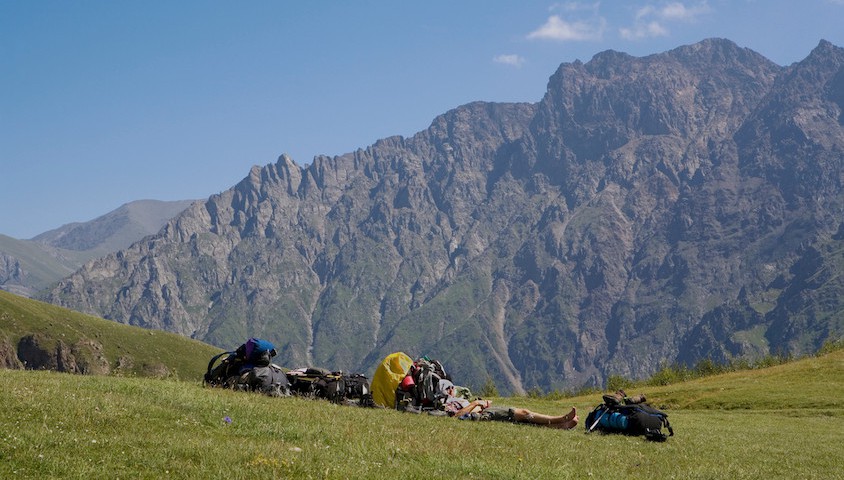We were barely a quarter of the way up Mount Feathertop when the rumblings began. I hung back to keep him company, allowing the two young gazelles who accompanied us to bound on ahead. I was struggling a bit myself so it suited me to potter along at the back. I didn’t want to blow up too early and it allowed more time for me to take in the scenery and to pace myself so that I’d have the energy to set up camp and make it to the summit that afternoon.
I teased and cajoled him but the grumbling continued. Then a confession blurted out – it was his first hike in more than a decade. Not only that, he estimated it had been equally as long since he’d last exercised.
“Are we nearly there yet?” he complained. “How far to go?”
‘My God!’ I thought. It’s like hiking with my six-year old.
We can’t always choose our hiking partners. And even when we do, we may not know how they’re going to respond when they realise they’re not physically conditioned to the challenge. Or perhaps we find out too late that they’re ill equipped to deal with adversity or sudden weather changes.
In the past I’ve been shadowed by a needy South African through Cappadocia’s heavily eroded valleys, all because he couldn’t bare the thought of being left alone in the hostel back in Göreme. I’ve been forced to spend several weeks in the company of an alcoholic bigot on a hiking expedition in western Tibet. And I clashed with our Ethiopian guide in the Simien Mountains, where we bickered constantly over trifling issues.
Back in 2001, I was invited to join a trekking party that planned to summit Mera Peak in Nepal. By that stage I considered myself to be a reasonably seasoned hiker who, through first-hand experience, had learned about the pitfalls of altitude-related maladies. I’d suffered mild doses of cerebral oedema in Borneo and Kenya and even Nepal itself, so I knew the risk that this 6,500-metre mountain posed. And the risk was that it could kill you, especially if you underestimated it. Not everyone in our group seemed to grasp that though.
One fellow, who had barely hiked to the end of his driveway, was intent on using Mera Peak as a steppingstone to higher grounds. Every conversation with him seemed to be littered with references to climbing into the ‘Death Zone’ after he’d seen something about it in a television documentary. It mattered little to him that the label had been struck after countless mountaineers – experienced ones – had died while climbing above 8,000 metres.
The fact that Mr Death Zone wore leathers and rode a Harley Davidson and had an unpredictable temperament spared him from ridicule, though the mountain wasn’t so forgiving. For most of our 30-day expedition, he trudged on slowly at the back of the field, hindered by a mild stomach bug and a lack of fitness that forced him to reflect on his own frailties.
Neil Fahey, writer of the award-winning Bushwalking Blog, remembers his Inca Trail hike in Peru being soured by the company he kept.
“My hiking partner had sore feet, but it was his attitude that was the real problem. I don’t think I heard a single positive word come out of his mouth. We were an hour behind the rest of the group on our third day and we didn’t arrive at camp until well after dark. I don’t think I can remember any other day of hiking that felt as long as that one.
“We completed one more multi-day hike together after that and the experience was similarly awful. While ascending 1200 metres up a steep switchback trail out of a canyon, I got so tired of the whingeing and him having to stop every few minutes that I decided to physically push him along for some sections of the climb.”
Differing fitness levels can often be the cause of delays that lead to friction within a hiking group, especially if all that the laggard contributes to the hike is a poor attitude. Anthony Dunk, author of three bushwalking guides around Sydney and developer of the Handy GPS app, mostly hikes with people of similar ability and experience. Occasionally though, one slips through the net.
On one hike through the Colo Gorge area of Wollemi National Park, west of Sydney, Andrew walked with a friend who had never accompanied him before so he had little idea about how she’d perform. It was clear early on that he was the fitter of the two and she grew concerned about being able to return along the steep trail they’d walked in on. He therefore led her back along a creek bed, following a route he’d found quick and easy on a previous hike.
“It started to get dark well before we had reached the exit point and we had no torches, so I had to leave her and race ahead to find the exit point before visibility faded to nothing…”
…the story continues in Wild issue 154. Subscribe online today.



